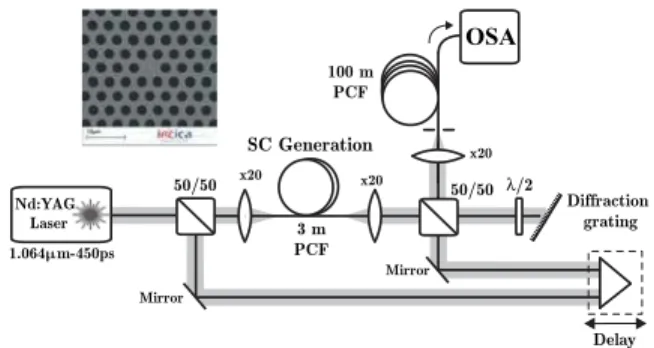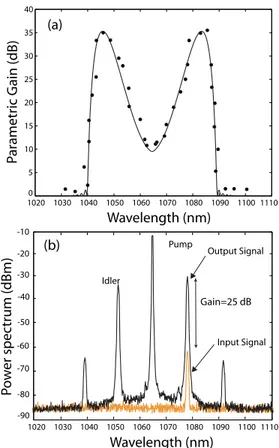HAL Id: hal-00504868
https://hal.archives-ouvertes.fr/hal-00504868
Submitted on 14 May 2021
HAL is a multi-disciplinary open access
archive for the deposit and dissemination of
sci-entific research documents, whether they are
pub-lished or not. The documents may come from
teaching and research institutions in France or
abroad, or from public or private research centers.
L’archive ouverte pluridisciplinaire HAL, est
destinée au dépôt et à la diffusion de documents
scientifiques de niveau recherche, publiés ou non,
émanant des établissements d’enseignement et de
recherche français ou étrangers, des laboratoires
publics ou privés.
Distributed under a Creative Commons Attribution| 4.0 International License
Demonstration of parametric amplification at 1µm by
use of a microstructured optical fiber
T. Sylvestre, Alexandre Kudlinski, Arnaud Mussot, J.F. Gleyze, A. Jolly, H.
Maillotte
To cite this version:
T. Sylvestre, Alexandre Kudlinski, Arnaud Mussot, J.F. Gleyze, A. Jolly, et al.. Demonstration
of parametric amplification at 1µm by use of a microstructured optical fiber. IEEE/LEOS Winter
Topicals Meeting, Jan 2009, Innsbruck, Austria. pp.187-188, �10.1109/LEOSWT.2009.4771721�.
�hal-00504868�
Demonstration of Parametric Amplification at 1
µ
m
by use of a Microstructured Optical Fiber
T. Sylvestre, A. Kudlinski, A. Mussot, J. F. Gleyze, A. Jolly, and H. Maillotte
Abstract— Highly efficient parametric amplification and
wave-length conversion have been demonstrated in the 1040-1090nm band by use of a microstructured optical fiber and picosecond pump and signal pulses.
Index Terms— Fiber optics amplifiers and oscillators;
Nonlin-ear optics, fibers
Fiber optical parametric amplifiers (FOPAs) and wavelength converters have a number of qualities which make them attrac-tive for all-optical signal processing and ultrafast optics [1], [2]. First attempts have been made in the 70’s in the visible domain by use of birefringent or multimode fibers, and later in the 1.3µm window with single-mode fibers (SMF) [1]. To date, however, most of FOPAs have been developed in the 1.55µm band to meet the requirements of telecommunication industry. Despite the number of potential applications in the 1µm band (Ytterbium and YAG wavelengths) [3], however, it is remarkable that no experimental demonstration of parametric amplification at 1µm has been done yet. Supercontinuum generation and four-wave mixing (or equivalently modula-tion instability) have been reported so far [4]. Here, we experimentally demonstrate highly efficient optical parametric amplification and wavelength conversion in the 1040-1090 nm band. This is achieved in the picosecond pulsed regime by use of a pump-probe technique. A microstructured optical fiber (MOF) was used to provide the anomalous dispersion required for phase matching at 1064-nm. A 40 dB maximum gain and +35-dB idler conversion efficiency have been achieved.
To demonstrate scalar OPA in fiber in the 1 µm region, we have to satisfy several criteria, namely, the phase-matching condition in the anomalous group-velocity dispersion (GVD) regime and a high nonlinear coefficient to provide efficient parametric gain. At such a wavelength, anomalous dispersion can be provide only by the use of a MOF whose photonic crystal cladding ensures a high single-mode field confinement together with the dispersion characteristics. Our PCF was manufactured in collaboration with IRCICA in Lille to provide both small anomalous dispersion and dispersion slope at a 1064-nm pump wavelength. The pitch and holes diameter are 4.13µm and 2.61µm, respectively. Its nonlinearity coefficient γ was evaluated at γ = 12W−1km−1. The fiber loss was T. Sylvestre and H. Maillotte are with the D´epartement d’Optique P. M. Duffieux, Institut FEMTO-ST, Universit´e de Franche-Comt´e, CNRS UMR 6174, F-25030 BESANC¸ ON cedex, France. E-mail: thibaut.sylvestre@univ-fcomte.fr.
A. Kudlinski and A. Mussot are with the Laboratoire de Physique des Lasers Atomes et Mol´ecules, Universit´e de Lille 1, CNRS UMR 8523, 59655 Villeneuve dAsq cedex, France.
J. F. Gleyze and A. Jolly are with the Commissariat Energie Atomique (CEA), Centre des Etudes Scientifiques et Techniques Aquitaine, Chemin des sabli`eres, 33114 Le Barp, BP2, France.
evaluated at about 15 dB/km at the pump wavelength. Because of its small core diameter and large air-fill fraction, the zero-dispersion wavelength (ZDW) is centered at 1063 nm (β3=0.056 ps3km−1). To pump our PCF in the vicinity of the
ZDW we used a Q-switched powerchip laser emitting 450-ps pulses (FWHM) at a central wavelength of 1064 nm. The mean power of the 1-Kz pulse train exceeds 60 mW. The complete gain measurement setup is depicted in Fig. 1. The signal to be amplified is obtained by propagation of half of the laser power into a 3-m-long MOF such as to generate a supercontinuum (SC) pulse with nearly the same temporal duration [4], [5]. Because the PCF used to generate that SC exhibits a ZDW near 1064 mm as well, the supercontinuum spans from the visible to the infrared region and is quite flat around the pump wavelength. The SC pulse is spectrally dispersed by a diffraction grating before being launched into the PCF parametric amplifier. The diffraction grating (1500 line/mm) is adjustable such that only a small tunable fraction of the supercontinuum is coupled into the amplifier and that the residual pump wave that is present in the supercontinuum is eliminated. Note that the PCF’s core acts as a narrow-band spectral filter such as the small signal launched into the PCF has a 0.5-nm 3-dB spectral width. Maximum throughput is ensured by control of the incident polarization with a half-wave plate at the input of the diffraction grating. Because the parametric gain is polarization dependent, this half-wave plate is also used to align the signal polarization with that of the linearly polarized pump wave. The PCF parametric amplifier is pumped by the remaining half-power of the Q-switched laser, which is combined with the signal through a 50/50 beam splitter. We superimpose the pump and the signal pulses temporally at the entrance of the amplifier by adjusting the air delay line that has been incorporated into the pump path. A peak pump power of as much as P=10 W is coupled
50/50 3 m PCF SC Generation OSA Diffraction grating Delay 50/50 Nd:YAG Laser 1.064µm-450ps 100 m PCF x20 x20 x20 Mirror Mirror λ/2
Fig. 1. Experimental setup. Inset : SEM image of the microstructured fiber.
LEOS WINTER TOPICAL MEETING, INNSBRUCK, AUSTRIA, 12 -14 JANUARY 2009 2 1020 1030 1040 1050 1060 1070 1080 1090 1100 1110 0 5 10 15 20 25 30 35 40 Pa ramet ri c G ain (dB) Wavelength (nm) -90 -80 -70 -40 -30 -20 -10 Po w er s pe c tr um (dBm) Gain=25 dB -50 -60 Wavelength (nm) Input Signal Pump Idler (a) (b) 1020 1030 1040 1050 1060 1070 1080 1090 1100 1110 Output Signal
Fig. 2. (a) Spectrum of the PCF-based parametric amplifier. Circles, experimental results; solid curve, standard analytical gain theory. (b) Input and output spectra with 24 dB gain for a signal wavelength at 1078-nm.
into the 100-m-long amplifier while the power density of the input signal is typically kept 40 dB below that of the pump beam. This low signal power together with the short amplifier length guarantees that our measurements are performed in the small-signal gain limit. We obtained the amplifier gain simply by monitoring the signals output power on a spectrum analyzer while tuning the pump on and off. We first performed a measurement of the parametric gain bandwidth by tuning the signal wavelength and by keeping the pump power constant to about 5W. All our results are presented as filled circles in Fig. 2.(a) as a function of wavelength and are superimposed on the standard theoretical gain curve taking into account the fiber absorption [1]. As can be seen, the agreement is quite good. In particular, a maximum 35 dB gain and a full gain bandwidth over the range 1040-1090nm are obtained for that pump power. As an example, Fig. 2.(b) shows typical FOPA’s input and output spectra for a signal wavelength at 1078 nm. Note in particular that the signal pulse spectrum exhibits a high signal to noise ratio ( 50 dB) because the pump power is kept just below the modulation instability (or parametric ASE) threshold. By looking at the pedestal signal spectrum, we can see however residual parametric ASE noise.
To complete these preliminary results, we measured the pump power dependence of the parametric gain. To this end, we choose a signal wavelength at 1082-nm which corresponds to the maximum of the gain curve shown in Fig. 2.(a). Fig. 3
0 2 4 6 8 10 12 14 16 18 20 0 5 10 15 20 25 30 35 40 45 50 Pump Power (µW) Pa rametr ic G ain (dB)
Fig. 3. (a) Experimentally measured parametric gain versus the mean pump power for a signal wavelength at 1081-nm, Psignal=-60 dBm. The solid line is a theoretical fit.
shows the results in function of the mean pump power. As expected from theory, the parametric gain exponentially grows with the pump power, till about 40 dB, and then saturates because of the pump depletion. A maximum 35-dB wavelength conversion efficiency was also evaluated through measure-ment of the idler spectrum power. In this work, we have demonstrated simultaneous parametric gain and wavelength conversion in the 1040-1090nm band. This was achieved thanks to use of a highly-nonlinear microstructured fiber to provide anomalous dispersion at the pump wavelength. This microstructured fiber-optic parametric device provides efficient amplification and conversion for applications at 1µm such as chirped-pulse amplification [6], pulse optical replication, sampling and regeneration [7]. Although this preliminary ex-periment used Q-switched picosecond pulses, we are confident that it could still operate in the continuous-wave regime by using high-power Ytterbium fiber amplifier in combination with longer microstructured fibers. We also hope in the near future to move towards an all-fiber 1µm parametric device.
REFERENCES
[1] M. E. Marhic, Fiber Optical Parametric Amplifiers, Oscillators and
Related Devices, Cambridge University Press, The Edinburgh Building, Cambridge CB2 8RU, UK, 2007.
[2] J. Hansryd, P. A. Andrekson, M. Westlund, J. Lie, and P.-O. Hedekvist, “Fiber-based optical parametric amplifiers and their applications,” IEEE.
J. of Select. Topics. in Quantum Electron., vol. 8, no. 3, pp. 506–520, 2002.
[3] H.M. Pask, R. J. Carman, D. C. Hanna, A. C. Tropper, C. J. Mackechnie, P. R. Barber, J. M. Dawes, “Ytterbium-doped silica fiber lasers: versatile sources for the 1-1.2 µm region,” IEEE. J. of Select. Topics. in Quantum
Electron.vol. 1 (1), 2–13. 1995.
[4] W. J. Wadsworth, N. Joly, J. C. Knight, T. A. Birks, F. Biancalana, P. St. J. Russell, “Supercontinuum and four-wave mixing with Q-switched pulses in endlessly single-mode photonic crystal fibres,” Opt. Exp. vol. 12, no. 2, 209–309, 2004.
[5] J. M. Dudley, G. Genty and S. Coen, “Supercontinuum generation in photonic crystal fiber,” Rev. Mod. Phys., vol. 78, 1135–1184, 2006. [6] M. Hanna, F. Druon, and P. Georges, “Fiber optical parametric
chirped-pulse amplification in the femtosecond regime,” Opt. Exp. vol. 14, no. 7, 2783–2790, 2006.
[7] A. Jolly and C. Granier, “All–optical sampling with Sagnac switches using closed pump and signal wavelengths near 1 µm,” Opt. Comm., Vol. 281, no. 14, 3861–3871, 2008.

